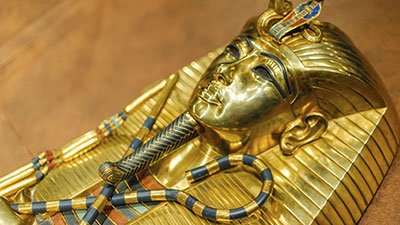Dr. John Ashton Articles
Latest Articles by Dr. John Ashton
-
April 30, 2015 from Unwrapping the Pharaohs
The next monarch was the boy-king Tutankhaten, presumably a son of Akhenaten by his secondary wife Kiya.
-
Book ChapterThe Pharaohs of the BibleJan. 28, 2010 from Unwrapping the Pharaohs
The Old Testament writings have been “sealed,” so to speak, over centuries by a Hebrew tradition for meticulous accuracy in preserving the Scriptures.
-
Book ChapterA Correct ChronologyJan. 21, 2010 from Unwrapping the Pharaohs
Because of the ambiguous, and often erroneous nature of the information upon which Egyptian chronology must be calculated, it is not possible to present a full list of Egyptian dynasties and dates.
-
Book ChapterThe Glory DepartsJan. 14, 2010 from Unwrapping the Pharaohs
The Egyptians often referred to “wretched Kush” in their inscriptions, and they had made frequent forays into their country, but the Nubians had the last laugh.
-
Book ChapterThe Third Intermediate PeriodJan. 7, 2010 from Unwrapping the Pharaohs
On the assumption that Dynasties 21 to 25 were consecutive, early scholars dated them approximately 1070-665 B.C., but a number of recent scholars have challenged this assumption.
-
Book ChapterThe Dynasty of RamesesDec. 31, 2009 from Unwrapping the Pharaohs
Mernpetah only reigned for ten years, during which time he built his own mortuary temple, and left a stela in it recording his military activities.
-
Book ChapterRameses the GreatDec. 24, 2009 from Unwrapping the Pharaohs
If he wasn’t the greatest of the pharaohs, he certainly thought he was. Having fathered over 50 sons and probably a similar number of daughters, we would have to concede to his claim for greatness.
-
Book ChapterTransition to a New DynastyDec. 17, 2009 from Unwrapping the Pharaohs
Tutankhamen died childless with no heir to the throne, and what happened next is open to question.
-
Book ChapterAkhenaten and Nefertiti the BeautifulDec. 3, 2009 from Unwrapping the Pharaohs
Akhenaten’s statues depict him as rather grotesque with an elongated head, thick lips, pinched cheeks, protruding abdomen, and thick thighs.
-
Book ChapterAmenhotep the MagnificentNov. 26, 2009 from Unwrapping the Pharaohs
According to one dreamer, Amenhotep III got off to a good start. He was of divine origin.
-
Book ChapterThe Pharaoh and the SphinxNov. 19, 2009 from Unwrapping the Pharaohs
Thutmosis IV was out hunting and fell asleep in the shadow of the Sphinx which appeared to him in a dream.
-
Book ChapterThe Mighty ArcherNov. 12, 2009 from Unwrapping the Pharaohs
Amenhotep aspired to follow in his father’s military footsteps, and early acquired skill with his bow and arrow, and in racing his war chariot.
-
Book ChapterThe Greatest of All the PharaohsNov. 5, 2009 from Unwrapping the Pharaohs
Thutmosis III did not take long to assert his authority and swing into military action.
-
Book ChapterHatshepsut, the Female PharaohOct. 29, 2009 from Unwrapping the Pharaohs
Thutmosis III was only about 12 years of age when his father, Thutmosis II, died, so Hatshepsut assumed the role of regent on his behalf.
-
Book ChapterA New Day Dawns Over EgyptOct. 22, 2009 from Unwrapping the Pharaohs
A dynasty is supposed to consist of a line of monarchs from the same family, but Manetho, who first divided Egyptian kings into dynasties, did not seem to know about this.
-
Book ChapterEgypt LiberatedOct. 15, 2009 from Unwrapping the Pharaohs
It was inevitable that sooner or later there would be a war of liberation, and it came at the end of the 17th Dynasty.
-
Book ChapterThe Mysterious HyksosOct. 8, 2009 from Unwrapping the Pharaohs
It is hard to say who were most confused—the kings who took over after Dynasty 12 ended or the historians trying to sort them out.
-
Book ChapterPharaohs of the OppressionOct. 1, 2009 from Unwrapping the Pharaohs
The texts of Sesostris III reveal him as a strong-minded character who burned the crops of his enemies.
-
Book ChapterThe Glorious Middle KingdomSept. 24, 2009 from Unwrapping the Pharaohs
The course of history in ancient Egypt has not been fully elucidated. Usually it has to be reconstructed from circumstantial evidence.
-
Book ChapterHow Do We Know What Happened?Sept. 17, 2009 from Unwrapping the Pharaohs
Before dealing with the Middle Kingdom it is necessary to discuss the sources of information on which our knowledge of this era is derived.
-
Book ChapterMore Shoddy PyramidsSept. 10, 2009 from Unwrapping the Pharaohs
To the northeast of the massive Step Pyramid of Saqqara is the mastaba of Mereruka, vizier of King Teti of the 6th Dynasty.
-
Book ChapterThe Shoddy PyramidsSept. 3, 2009 from Unwrapping the Pharaohs
Instead of layers of cut stone, the core consisted of a jumbled heap of stones piled up in the shape of a pyramid and then faced with limestone blocks.
-
Book ChapterThe Pyramid of MenkaureAug. 27, 2009 from Unwrapping the Pharaohs
Menkaure was the last great pyramid-building pharaoh at Giza; however, his tomb is the smallest of the Giza pyramids.
-
Book ChapterThe Pyramid of KhafreAug. 20, 2009 from Unwrapping the Pharaohs
Only the few lower layers of stone remain today, but it is of great interest because the lower half of the tomb chamber is exposed.

Answers in Genesis is an apologetics ministry, dedicated to helping Christians defend their faith and proclaim the good news of Jesus Christ.
- Customer Service 800.778.3390
- Available Monday–Friday | 9 AM–5 PM ET
- © 2025 Answers in Genesis

